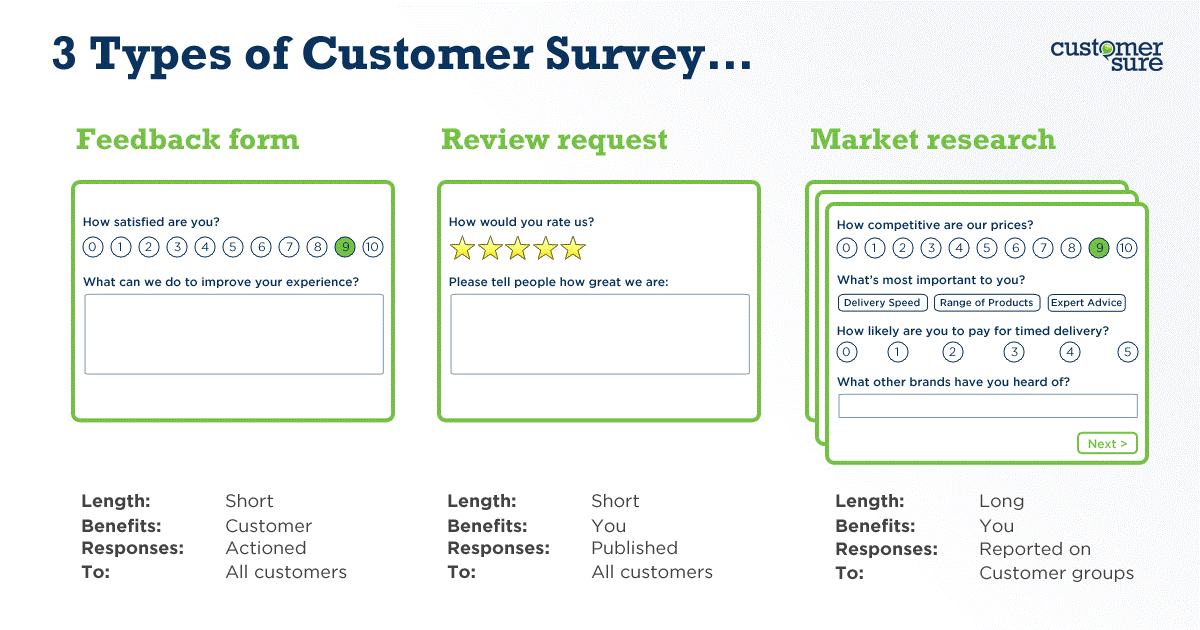If you want to send customer surveys which result in a measurable increase in satisfaction, you need to send the right type to the right customers at the right time.
Here Chris Stainthorpe of CustomerSure discusses the different types of customer survey, while explaining how to choose which type to use and when.
CustomerSure spends every hour of every day talking to people about customer feedback. Sometimes, people tell us:
Customer surveys don’t work! People hate receiving them!
They have a point.
On Planet Earth, in 2018, a lot of well-intentioned customer surveys are being sent. But good intentions don’t always translate to great results. If it’s your first time doing anything, you’re likely to make ‘rookie errors’ – and surveys are no different.
Like anything else, surveys are vulnerable to your organisation’s culture. Your colleagues will naturally suggest you do what’s “always worked” – even if in doing so, you prevent customers from telling you what would really work.
We’ve all been on the receiving end of bad surveys, which is why people will tell you they “don’t work”.
But it doesn’t have to be that way.
There are three different types of customer survey – and sending the right one to the right customers at the right time, for the right reasons is your first step to customer surveys that “work fantastically well, thanks very much”.
We’ll show you how to get it right.
First, let’s categorise surveys according to the following criteria:
Who benefits?
Ultimately, when the customer’s response to this survey comes back, who will feel the benefit of them having replied? Is it going to make your business better, their life better, or both?
What are you going to do with the response?
Again, assuming a customer, somewhere, replies to your survey – what happens to that reply? Does it get seen by people or an automated system? Does it get published anywhere?
If you’re sending surveys to improve customer experience, and people are asking you to respond but you’re sending their replies straight to Excel… You won’t succeed in improving that customer’s experience.
Who (should) get the survey?
Does this go out to your entire customer base? A segment? Hand-picked individuals?
How long is it?
Is this a 30-second snap survey, or something considerably more in-depth?
Three Types of Survey
You can send three different kinds of survey to your customers. Let’s look at them in turn:

Market Research Surveys
Are you looking to launch a new product? Or change the existing services you offer? Open an office in a new location, or alter your pricing structure?
This is what market research is for.
When done by professional researchers (because us mere mortals are terrible at writing questions that don’t reflect our own biases), market research surveys can give you valuable insights into what your customers (or potential customers) want you to do.
Market research surveys can be long – really long – but that’s OK, because you ask permission to carry them out, and sometimes give customers a ‘reward’ for them giving you their time.
The data you gather from your customers gets compiled into reports and used to help you make better business decisions.
Review Requests
Do you want to reassure potential new customers that you’re good people to do business with? (Or that you have good products?)
Ask your current customers to write you reviews!
Reviews are usually managed by your marketing department. It’s best to ask all your customers for reviews and deal with any criticism in public, so potential buyers can see that you’re listening.
Remember, though – reviews are for your benefit. Customers might leave you one as a favour, but they don’t owe you one. And if a customer is angry at you, it’s maybe not the best time to ask for favours. It’s safest (and dare we say, nicest?) to ask for private feedback first, and if people are feeling good about you, ask them to share the love.
Which brings us to…
Customer Feedback Forms
If you want to keep every single customer happy – meaning they stay with you longer and spend more – send short customer feedback forms at an appropriate time.
It’s ideal if you’re able to do this every time you interact with a customer, but if that’s not feasible, you’ll be able to find something that works.
Ask questions that your customers want to answer, and make sure you deal with the responses.
There are few certainties in business, but a brilliant feedback process is as close as it comes to a cast-iron guarantee of increased profitability. If you’re fixing the problems that every customer has, why wouldn’t they stay with you? Why wouldn’t they recommend you to others?
So Where Do Bad Surveys Come From?
So, when someone tells us that customer surveys don’t work, more often than not, we find out they mean the wrong kind of customer survey, at the wrong time, didn’t get results. Or maybe even they picked bits of all three, mashed them together, and hoped for the best. Maybe someone wanted to improve satisfaction but sent market research surveys. Or wanted to increase retention, but sent review requests.
This is totally natural. We all stand on the shoulders of giants.
When deciding to ‘send a customer survey’, it’s not good practice to look at some examples of other people’s surveys and then pick out the bits you like and build your own. When doing this, you don’t get to see the decision-making that went into these surveys, you don’t know if they’re appropriate for your circumstances, and as a result, when you borrow ideas, sometimes they work, sometimes they don’t.
Stopping Bad Surveys: Use the Right Language
One tactic CustomerSure has seen produce brilliant results is very simple:
The words we use to describe things matter. Using the most-accurate possible words to describe what we want from a project leads to the best-possible results from the project.
Which is why CustomerSure suggests you ban the words “customer survey” from your team. It’s too vague. What sort of survey?
It might sound crazy, but this is literally why traffic lights in Japan are blue. (The Japanese word ao covers colours that Westerners would consider blue but also many things they would consider green.)
If you call things ‘blue’, they end up… well, blue. Even if someone else wanted them to be green.
Call everything you send to customers a “customer survey”, and you’ll end up with a mash of different types of survey, much like the “grue” and “bleen” traffic lights of Japan.
If you want to do market research, call it market research. If you need reviews, ask for reviews. If you want to improve satisfaction, put a brilliant customer feedback process in place.
CustomerSure’s hands-on guides, full of industry-tested advice, might be a great place to start.
Author: Robyn Coppell
Published On: 6th Jun 2018 - Last modified: 13th Nov 2018
Read more about - Guest Blogs, CustomerSure















